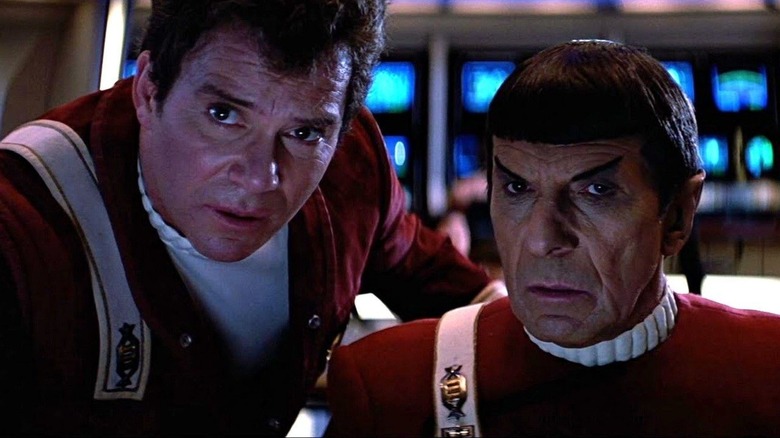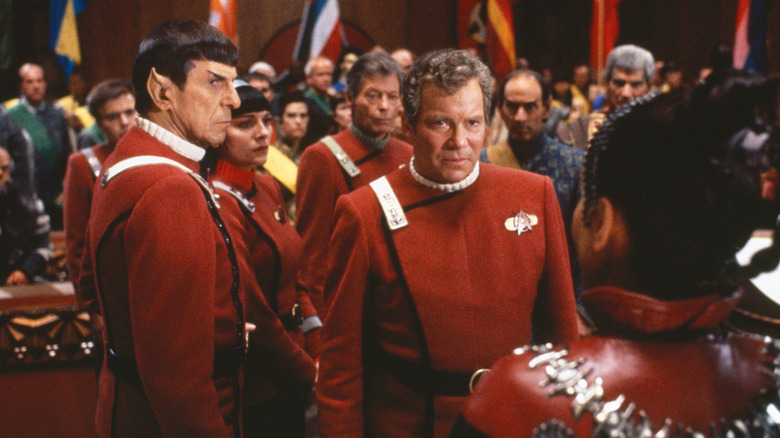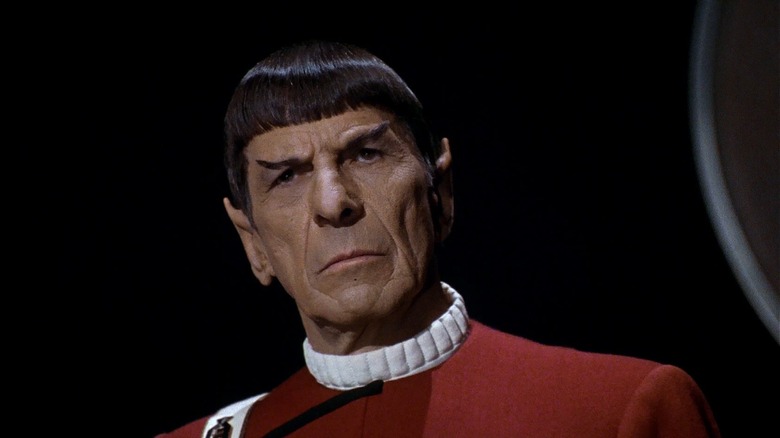Syfy Spent Thousands On Leonard Nimoy And William Shatner Star Trek Ads You Probably Missed
Trekkies and sci-fi nerds in the early 1990s were riding high. The original "Star Trek" cast wrapped up their final movie together with "Star Trek VI: The Undiscovered Country," and "Star Trek: The Next Generation" was striding through its best period. Most importantly, the Sci-Fi Channel launched within nerds' cable packages in 1992, and a panoply of riches opened up. Some previously inaccessible shows were suddenly regularly rotated through the Channel's calendar, and classic sci-fi movies were finally gathered under one umbrella. About 30 years ago, the Sci-Fi Channel slate was embarrassingly good, containing "Planet of the Apes" movies, "Star Trek" reruns, "The Incredible Hulk" reruns, airings of "Starman," and curious documentary shows like "Mysteries from Beyond the Other Dominion" and "Inside Space." Kids got to enjoy "Transformers," "Stingray," and "Space: 1999." Adults got to watch "Night Gallery" and "Tales from the Darkside." 1992 Sci-Fi Channel was truly TV at its peak.
Barry Schulman had been with the Sci-Fi Channel since its start, and he remembers the glory days in detail. He was interviewed for the indispensable book "The Fifty-Year Mission: The Next 25 Years: From The Next Generation to J. J. Abrams," edited by Mark A. Altman and Edward Gross, and he remembered the production of what was to be one of the more ambitious advertising tie-ins the network could have possibly received. It seems that the Sci-Fi Channel wrote and paid for a series of extended "Star Trek"-inspired interview-style infomercials to be hosted by Leonard Nimoy and William Shatner — Spock and Kirk themselves! — to run after individual episodes.
Sadly, due to poor ratings, the ads were only sparsely seen.
The 90-minute timeslot
Schulman admitted that the fate of the Sci-Fi Channel and the popularity of "Star Trek" were interlinked. The network launched with "Star Trek," and was reliant on Trek's cultural presence to draw in new veiwers. After all, Schulman reasoned, one cannot have a station called "the Sci-Fi Channel" and not contain one of the most famous sci-fi properties of all time. He knew that Trek was required, saying:
"[T]he night we launched the channel, we ran three 'Star Trek' movies back-to-back. The first three 'Star Trek' films had never been owned by one entity at the same time ever. The cable systems, the advertising community, and the viewers expected to be given the best, most important science-fiction projects that had ever been made. 'Star Trek' and 'Star Wars' were both that. There was no question that it added to our distribution on cable systems and we got a lot of attention."
He also noted that, "Viewers who hadn't discovered the channel discovered it as a result of all the press coverage and the marketing about 'Star Trek.'"
Of course, programming "Star Trek" presented a technical problem. In the late 1960s, when the hour-long "Star Trek" originally aired on NBC, the broadcast ad breaks only totaled about 10 minutes, leaving 50 minutes of show. By the early 1990s, ad time had grown to 16 minutes, leaving only 44 minutes of show. That would mean any new broadcast of "Star Trek" would, by advertisers' decree, need to be shaved down by six minutes.
Shulman's solution was to expand the "Star Trek" time slot from a 60-minute span to a 90-minute span, including all 50 minutes of "Trek" as well as whole ad breaks. He'd then pad out the remainder of the 90-minute slot with Shatner/Nimoy intro/outro segments. Brilliant.
Alas!
Expanding "Star Trek" into a 90-minute show is a wonderful idea. Most Trekkies tuning in would have likely seen the original episodes, and hiring two of the show's biggest stars to reminisce, offer some unknown production history, and chinwag politely about their acting experiences, would have been catnip to fans. Altman's and Gross' book notes that Nimoy was indeed hired and paid, and even did extensive research to prepare for his segments. The Sci-Fi Channel even built out a replica set of the bridge of the U.S.S. Enterprise in which Nimoy and Shatner would be able to film their segments.
At the end of the day, sadly, not enough Trekkies were tuning into the "Star Trek" reruns on the Sci-Fi Channel. It likely hurt that "Star Trek" was still in syndication on many networks, and reruns would often air daily; this author's local station — KCOP in Los Angeles — once ran regularly "Star Trek: The Next Generation" and the original "Star Trek" back-to-back. "Trek" was, in this case, perhaps too ubiquitous to fully function as an advertising tool for the Sci-Fi Channel.
Still, Shulman dreams of how popular these "extended" episodes might have been, saying:
"It was very important for us to get press. We had a limited advertising budget, so if we could get written up, the press would pick up on it. That, in effect, was our marketing. People would come to see Nimoy and Shatner reflecting on this iconic series. We spent about a quarter of a million dollars building the set at Raleigh Studios. The set looked like the Enterprise. It was beautiful."
In the age of streaming, shows like "The Ready Room" and other recap programs are common. In 1992, it would have been a coup. The good news is that you can actually watch all of these bumpers with Shatner and Nimoy on YouTube.


